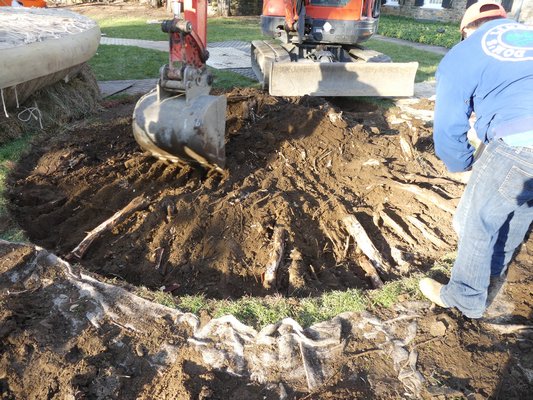

In last week’s column, I began the story of how a centenarian maple tree in northern Westchester County, which was the anchor of the landscape where it lived, began to fail and ultimately had to be taken down, only to become firewood; how an idea, in the form of a copper beech tree, led to just such a tree being located at the East Hampton nursery of Whitmores; and how that beech tree was ever so gently moved to its new upstate home, where it replaced the maple.The 12-ton, 26-foot-tall copper beech was carefully taken off a flatbed tractor-trailer and slowly moved over four hours from the unpaved country road, down a driveway, across an old cattle field, only to get stalled by some young(ish) maple trees that were blocking the access through an old cattle grate. A tree crew that happened to be working nearby was able to do some quick limb trimming, and the beech once again began its journey toward its new home.
The process of moving the tree through the next field was challenging as well. The front-end loader had to proceed backward to keep the tree stable, and every 40 feet or so the entire effort would come to a stop while the crew moving the tree moved back 40 feet to pick up the 8-foot lengths of rubber matting, which now had to be moved behind the loader so it could proceed forward once again.
This crawl-and-move routine continued for another three hours, around two septic fields, a drainage swale and up a vast bluegrass lawn, without leaving a trace that 12 tons of tree and tractor had just come by. But, by the end of the day, the beech was at its final destination, and as the sun set behind the woods to the west, the tree was eased off the loader’s forks, set upright and left to rest for the night.
Early the following morning, the labor crew returned with the intention of digging the new planting hole and settling in the new tree. But it wasn’t going to be quite that easy. It rarely is.
A small crawling excavator was at the ready to do the digging, and a diesel-powered wheelbarrow was ready to move soil around. The sod from the original planting, where the maple was, was cut back so a larger planting hole could be dug, and with the root ball being just over 11 feet in diameter, a hole of at least 15 feet in diameter was planned.
The top layer of soil was easily removed, as the stump of the maple had been ground down when the tree was removed. But as the crew got down about 6 inches, they realized that the remaining stump below was huge and not budging—and very much intact.
A trench was dug around the stump and chainsaws were used to sever the 8-to-10-inch anchoring roots from the stump, and that alone took two hours—but it seemed futile. The original maple was, indeed, well rooted and not giving up the ghost.
For hours, the crew worked with shovels, picks and chainsaws, but finally the stump grinder had to be called in to grind out the mass of what was left of the old oak.
It was now 2 in the afternoon, on the day after the tree had arrived, and by 3 the new hole was dug. For the next hour, the beech was gently and gingerly eased into the hole and tweaked this way and that so it was as perfectly situated as possible. The south side was again facing south and, with a jimmy this way and a slight leveling of the ball, the tree was set.
At this point, three cables were installed to keep the tree stable while it steadied in its new home; the cables were so expertly installed that they could easily be missed by a casual observer.
The burlap and heavy twine around the ball that had so perfectly been set by Whitmores was now removed, and soil was added to fill the gap between the ball and the surrounding earth. Darkness was again descending, and a tired crew once again called it a day.
The third day was again a brilliant, sunny day, and the first order of business was to water the tree. So, how much water do you give a 12-ton tree at planting? Lots. But when all the hose bibs have been drained and blown out for the winter, where will the water come from?
We laid 250 feet of garden hose back into the basement of the nearby house and drew water from the house’s well supply—600 gallons of water, to be exact. The water not only rehydrated the root ball but also helped in settling the back-filled soil that was added at planting. A few hundred gallons, then a wait to let it seep and settle. Then, a few hundred gallons more. Then, done.
The machines were taken away. The lawn around the new tree was primped and raked. Everyone from the landscape architect to the landscape contractor, his crew and yours truly had big smiles on our faces—and, yes, the tree looked absolutely perfect. If trees are ever happy, this one was grinning.
But there’s more.
While the ground gets colder and begins to freeze, the tree really needs little care until spring. But if there’s a warm spell, like a week-long winter thaw, we may water the tree again.
As spring approaches, we’ll watch the buds and hope to see them swell in April and May, then unfurl into their characteristic coppery-colored, deeply veined foliage as the earth warms and the tree becomes fully awake.
We may do some light feeding with humates and liquid organics at some point, but the critical thing we’ll watch for is the leafing out and signs of twig dieback. Some twig dieback is to be expected, but too much will indicate that, despite our best efforts, there was some root damage in transport or planting.
When will the tree start growing again? New root formation will be almost immediate as the soil warms, but the shoot system is much slower. I was taught a rule of thumb years ago: For every inch of trunk diameter, new shoot growth is retarded (somewhat) by a year. Not what my boss wants to hear, though. Time will tell. We’ll also keep our eyes out for any signs of insect problems, and we’ll water, water, then water again, and for several years.
Larger and more expensive trees have been moved. But this was personal for me. I had adopted a munificent specimen, and now it’s my responsibility to nurture and steward it so it will thrive and live on for decades to come.
I wish you all a very happy and festive holiday season. Be back in January with all of next year’s new stuff.
In the meantime, please keep growing!
 More Posts from Andrew Messinger
More Posts from Andrew Messinger